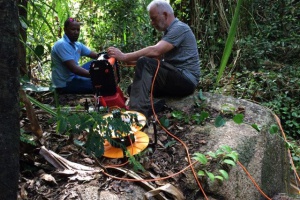Seychelles can extract groundwater, survey by Swedish groups indicate
General |Author: Patsy Athanase and Betymie Bonnelame | December 17, 2016, Saturday @ 14:13| 7613 views
A Swedish-based Water Harvesting Company carried out investigations at ten sites on Mahe, Praslin and La Digue to look for the presence of groundwater. (Ministry of Environment, Energy and Climate Change)
(Seychelles News Agency) - A preliminary study by Swedish-based Water Harvesting Company and the Swedish Geological Survey Unit indicates there are sites on the three main islands, Mahe, Praslin and La Digue, where water can be extracted from boreholes.
The study was done over a two-week period in December. The findings were presented on Thursday.
Johan von Garrelts of the Water Harvesting Company said 100 possible sites were chosen and then narrowed down to ten sites -- six on Mahe, two each on Praslin and La Digue.
“We had to choose areas where we can transport the drilling equipment, so it’s a question of accessibility, and it also has to be a site where the water is needed and where the installation can be connected to existing piping system,” said Garrelts.
Garrelts added that a number of conditions could indicate the presence of groundwater and these were carefully looked at during the investigatory stage.
“First of all we looked at the topography, including the tectonics, to see where the fissures are and if they are vertical or horizontal and we follow the streams which are natural, where we can actually see the water,” Garrelts said.
According to the Public Utilities Corporation (PUC) which is overseeing the project, the second phase will start in February with the drilling to confirm the preliminary tests and quality and volume of water available at each site.
PUC’s Deputy Chief Executive Officer, Joel Valmont said, “At the second stage we will look at how many more boreholes will be required or can be implemented based on potentials at these locations, for us to retract the water.
The minister for environment, climate change and energy, Didier Dogley said if everything goes according to plan, Seychelles will be harvesting groundwater by next year.
“Most of the trials will be done by the end of March and once they’ve determined there is enough water and the quality is good then the local authorities will decide when we should start drilling and pumping the water,” said Dogley.
Groundwater exploration in Seychelles, an archipelago in the western Indian Ocean, started in October last year as part of the country’s strategy to address the issue of water shortage.
Although the island nation with a population of 93,000 people, records on average 2,300 millimetres of rain every year, during the dry season in the south-east monsoon from May to October, water shortage persists, resulting in rationing enforced by PUC.
Garrelts said the boreholes that PUC will be tapping will not pose a threat to the environment
“This process we are doing doesn’t do any harm. The only thing you will see afterwards is the top of a pipe coming up from the ground and this part is only about 200mm wide in diameter,” he said.
Garrelts said borehole could be a long-term solution for Seychelles as it could be used not only to extract water but to infiltrate it.
“As long as it is raining roughly 3000 millimetres in a year on average, you cannot have water shortage, so you have to learn how to catch the water, and help nature catch the water.”
In an interview with SNA in November last year, Minister Dogley explained how the process will work for Seychelles.
“When it rains you let the water accumulate in the cracks within the rocks, the accumulation of water will be like a dam only underground, when it gets really dry, there will be an additional source of water instead of using 100 percent desalination, ” Dogley had said.
Back
